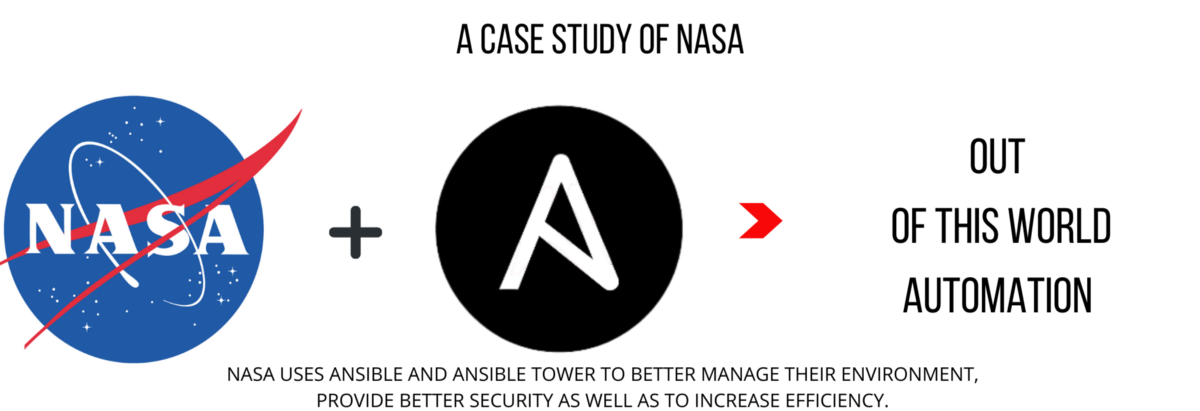There are no items in your cart
Add More
Add More
| Item Details | Price | ||
|---|---|---|---|

In today’s world of cloud, DevOps, and automation, Ansible has become one of the most popular tools for managing IT infrastructure. But Ansible isn’t just used by startups and enterprises—it’s also trusted by Nasa for its mission-critical operations. From automating servers to ensuring security compliance, Ansible plays a key role in helping NASA focus on innovation rather than repetitive manual tasks.
What is Ansible ?
Ansible is an open-source automation platform from Red Hat that simplifies IT tasks like configuration management, application deployment, and cloud provisioning using a simple, human-readable language called YAML to write playbooks. It is agentless, meaning no software needs to be installed on the systems it manages, connecting instead via SSH or other protocols.
Features & Benefits of Ansible
1. Simple & Human-Readable
Ansible uses YAML, which is easy to read and write even for non-programmers. This makes automation more accessible across IT teams.
2. Agentless Architecture
No agents are required on target systems—Ansible connects over SSH or WinRM. This reduces setup complexity and ongoing maintenance.
3. Scalable
Whether managing a few servers or thousands, Ansible scales seamlessly. It’s equally useful for startups and large enterprises.
4. Cross-Platform
Ansible supports Linux, Windows, cloud platforms, and even networking devices. This flexibility makes it a one-stop automation solution.
5. Idempotent
Playbooks deliver consistent results regardless of how many times they run. This ensures stable, predictable, and error-free environments.
What Ansible used for ?

NASA needed to move roughly 65 applications from a traditional hardware based data center to a cloud-based environment for better agility and cost savings. The rapid timeline resulted in many applications being migrated ‘as-is’ to a cloud environment.
Solution to this Challenge
The solution was to leverage Ansible Tower to manage and schedule the cloud environment.
How NASA is using Ansible
Ansible Tower is an enterprise framework to help you control, secure, and manage your Ansible automation at scale. Ansible Tower is a web-based interface for managing Ansible. Ansible Tower lets you launch playbooks with just a single click.
Before and After Using Ansible By NASA
While parts of the technical staff would sometimes use Ansible core for some tasks, previously NASA WESTPRIME was using shell scripts and manual SSH-based administration.
After testing, NASA decided that Ansible was the best fit for them, due to:
1. Automated Server Patching
NASA web app servers are routinely patched through Ansible Tower using a simple 10-line playbook. This ensures systems stay secure and updated with minimal manual effort.
2. Rapid Security Remediation
Ansible helped NASA quickly fix critical OpenSSL vulnerabilities and other security issues. This saved valuable time and provided a fast response to high-risk threats.
3. Faster Website Updates
Both the full and mobile versions of www.nasa.gov are updated weekly using Ansible. The process takes just about 5 minutes, improving efficiency and reliability.
4. Improved AWS Inventory Management
By integrating Ansible facts into CloudAware CMDB, NASA gained granular visibility of AWS resources. This made it possible to organize and manage their cloud inventory more effectively.
Ansible has proven to be a game-changer for organizations like NASA by simplifying automation, improving security, and ensuring faster, more reliable operations. With its agentless design, scalability, and ease of use, Ansible helps teams focus on mission-critical tasks instead of routine maintenance.
NASA’s adoption of Ansible Tower shows how powerful automation can drive efficiency, security, and innovation—even in the most complex and high-stakes environments.
"DevOps is the union of people, processes, and products to enable continuous delivery of value to our end users." - Donovan Brown
Ayushman Sen is a DevOps Engineer at CloudDevOpsHub with a passion for cloud technologies and automation. He enjoys writing blogs to share his DevOps knowledge and insights with the community. A true DevOps enthusiast, Ayushman is also passionate about traveling, listening to music, and playing musical instruments.

Ayushman Sen
DevOps Engineer at CloudDevOpsHub